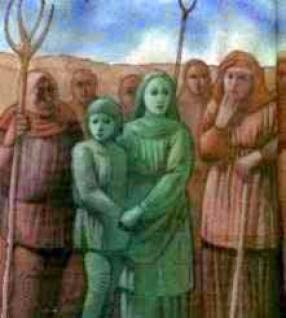The Green Children of Woolpit 1: All Hail John Clark! January 22, 2015
Author: Beach Combing | in : Medieval , trackbackThe green children of Woolpit is one of the most fascinating stories to come out of our medieval records. Two children, coloured green, without any knowledge of English and with unusual dietary requirements turn up in a pit just outside a Suffolk village. They are adopted by the local lord, one dies and the other adapts to East Anglian life eventually becoming ruddy red and marrying a local. Yes, yes, you are all saying, Middle Age stuff and nonsense. The fascinating thing though is that this story was not something that took place two or three hundred years before it was recorded. It was remembered perhaps a generation later by two chroniclers, one who had known the local lord’s family who had seen the children, in fact, the girl had worked for the family. Medievalists have generally run a mile from this complex of tales and memories: or just offered a few throwaway comments. Much of the writing on the green children has fallen instead to folklorists and Forteans, who have not always been qualified to deal with twelfth- and thirteenth-century sources. Very often an essay appears because a writer believes that he or she has solved the mystery: the green children were badly malnourished Flemings from a village over the hill, the Green Children had passed through a black hole en route from Alpha Centauri, the Green Children were fairies, who had been transposed to middle earth… None of these are, let’s say, entirely convincing.
What can Beach possibly offer to make a post on the Green Children worthwhile? Well, the truth is absolutely nothing. But John Clark can. John is a London scholar who has pottered away on a strikingly wide range of subjects over his professional life and he has made the Green Children something of a speciality. In fact, he has published a number of essays on the topic all (?) of which are now available on academia.edu. He has also though published a single essay (still in draft, a work in progress) that runs to over a hundred pages and that is quite simply the best thing ever written on the green children. If John could just write another 10,000 words on the topic (even the inclusion of some of the early modern sources for the Green Children would do the trick in appendices), then we would have book of the year material. Does John solve the mystery of the Green Children? Of course, not. The mystery seems to be insoluble. But he provides an excellent survey of the literature and a surgical and sensitive analysis of the two medieval sources (and the Latin with English translation). John also gets across better than anyone else who has ever looked at the question how, while the green children presumably had a fairly pedestrian explanation, the population of Woolpit (where they ended up), believed that the green ones were supernatural beings. Whatever the green children really were that is (extended metaphor warning) gold sifted from the stream of medieval folklore: and not many prospectors are successful in getting anything valuable out of that crashing torrent.
As a longtime fan of the green children Beach thought that he would have a Green Children Half Week on Strange History, with three posts, to try and get to grips with three elements that continue to mystify him, where Beach does not have the instruments to solve the problem, but where some reader or random Googler might have the necessary special knowledge. Each element will get a post, the first tomorrow, the second Friday and the third Saturday. Perhaps any special insights might even find their way into John’s essay and human knowledge will continue its ugly crab-like walk forward?
The first problem, and the one that has most frustrated Beach, is the impossible relationship between our two medieval authors William of Newburgh and Ralph of Coggleshall.There is something strange going on there.
The second problem is the question of why the children were green, not the folklore explanation, which is though not as straightforward as we might think, but a half decent medical explanation.
The third problem is the bizarre description of the children eating (and initially failing to eat) beans.
Beach will try and set out all the relevant information day-by-day, but John’s essay is the natural starting point for any proper investigation. Beach has flu so the timetable could go up in flames…



